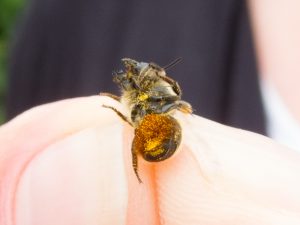In 2009 The Lancet said that Climate Change was the biggest threat to human health of the 21st Century. I would say that Antimicrobial Resistance (AMR) is close behind. Following the description of AMR as a catastrophic threat by the Chief Medical Officer in 2011 there seems to have been more of a focus from governments on the issue. Indeed, during antibiotic awareness week last year there were even radio adverts with catchy ditties. The UK government published its five year AMR strategy in 2013, interestingly they are about to need a new one!
The main issue is that bacteria and other microscopic organisms can evolve to have resistance to our currently used antimicrobials and have done since shortly after the widespread use of penicillin. We are also not currently bringing any new drugs to market, possibly because there’s not a lot of profit to be had in it. We depend on antimicrobials for both human and animal health. Without antimicrobials there will be no safe surgery, no chemotherapy and no caesarian sections. We will be back at the point where there is the potential to cut yourself in the garden or even bite the inside of your own mouth and a few days later have died from the infection. Despite this there is not even much funding for the research into new antimicrobials. In the business as usual scenario it is estimated that by 2050 more people will die worldwide from antimicrobial resistant infections than from cancer; including 390,000 in Europe.
Most bacteria in a colony are killed by the antibiotics, but some with a resistance remain. These no longer have to compete with the other bugs so can multiply more rapidly and the population grows, AMR develops. For a brilliant depiction of this, see the excellent MIT video. Antimicrobials can get into the environment during production, during use and in the waste. Therefore, there are many areas that need action and there doesn’t seem to be agreement on how big each of the problems is and how to tackle them.
The government, in its action plan, has recommended better stewardship of the antimicrobials we currently have. Public Health England have recently said that one in five GP antibiotic prescriptions is inappropriate But, within the EU, the number of antibiotics prescribed varies massively. The standard measure is the Defined Daily Dose (DDD) per thousand of the population per day. In the UK we currently stand at a level of 22.84 (as of the last available figures published for 2015). This means that on average each of us in the UK gets 4 days of antibiotic treatment each year. However, the DDD for the Netherlands is 11.7 – half that of the UK. Do those living there get sick less often? Do they have better hygiene or vaccination standards which means that people don’t have the bugs in the first place and therefore don’t need the antibiotics? Or does this mean that rather than 20% of antibiotics being unnecessary we are closer to 50%? For the record France and Belgium have DDDs of over 30.
The UK government aims to cut innapropirate prescriptions by 50% by 2020 (that is inappropriate prescriptions, not antibiotic use), but will this be enough to make a difference, will the reduction in the level of antibiotics in the system reduce the probability of resistance in human pathogens ? It is not clear that these levels will be enough, and the 2% reduction in all prescriptions for antibiotics that was achieved from 2013-2015 is certainly not likely to make any impact.
Part of the issue of incorrect prescription comes back to the fact that in many cases antibiotics are prescribed for things that are not bacterial infections – flu (proper flu, manflu and diva flu) being a case in point, but other illnesses do not always have an obvious cause and look like an infection. Also, when a patient is prescribed an antibiotic which doesn’t cure the infection, it doesn’t mean it hasn’t worked, the non-resistant bugs will have been killed, but a different antibiotic is needed to kill these double-hard b******s, therefore promoting further resistance.
There is debate about whether hospitals are a major source of antimicrobial resistance, after all they use a lot of antimicrobials every day. In fact in one conference with four speakers, one didn’t mention it, one said that the bugs were so diluted and disperse when they entered the waste water treatment plant (WWTP) that it wasn’t a problem, another said that there was resistance found in waste water treatment plants to antibiotics that are only used in hospitals, and another pointed to a far bigger problem, but one that the health sector could again help deal with. Which one is right?
The issue with the antibiotics from hospital is not to do with the way they dispose of them – all waste medicines are incinerated, but it is to do with poo – we don’t metabolise all of the antibiotic, so much is flushed away. The problem with hospitals is therefore perhaps not how much they use (only about 10% of that DDD) but what they use. As they use some of the last resort antibiotics then resistance to these has a higher probability of occurring in the waste water from hospitals.
Most of the antibiotics in use come from the community and again get flushed to the WWTP. So, again is this a problem? Unfortunately yes. Unlike us mammals who can only pass our genes between the same species, bacteria can pass genes between different species (known as horizontal transfer). Therefore different bugs can pass on different characteristics, such as resistance to drugs, to completely unrelated species – including potential human pathogens such as E Coli. The WWTP can act as a big mixing vessel and unfortunately they are mainly set up to take solids out of the water and some chemicals, not bacteria. In fact, they rely on bacteria to do some of the work of cleaning up the water – will the antibacterials in the water affect these bugs?
Once the water has been cleaned up, the sludge is then put onto the fields, along with anything living in it – will it then end up back in the food chain?
However, one of the biggest causes of antimicrobial resistance in the environment is from the production of the drugs themselves. Most of these are manufactured in China and India where the outflows into the local rivers are not monitored or regulated. Studies have found levels in some waste water that were as high as would be found in patients being treated with the antibiotics. With the movement of people and food round the world in a matter of hours, it takes little time for antimicrobial resistant genes formed from these effluents to find their way to major centres of population.
In the UK government strategy on AMR, there is little mention of the role of the pharmaceutical industry’s impact on the environment, most of the emphasis is on finding new drugs:
“Industry has a corporate and social responsibility to contribute to work to tackle AMR by finding ways of extending the life of antibiotics, making the supply of effective antibiotics sustainable, facilitating society in being better custodians of these valuable resources and using them optimally both now and the future. “
Most pharma companies do not disclose how much they or their third party manufacturers discharge. And, here’s where the Health Sector comes in. Whilst it continues to reward companies for bringing in cheaper alternatives, rather than for having a sustainable supply chain, there is little incentive for companies to clean up their act. In Denmark and Norway this is changing with hospitals creating incentives for pharma companies to improve pollution control during their procurement of drugs. It is time the UK government and NHS followed their lead.






